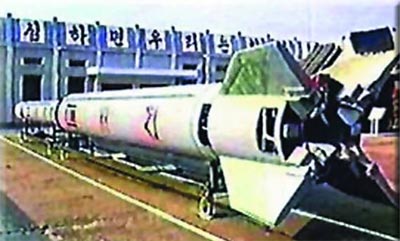A space launch vehicle by any other name…by Brian Weeden
|
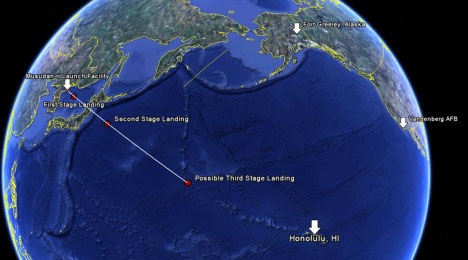 Figure 1: August 1998 Taepo dong 1 flight path |
Launched from the Musudan-ri rocket facility on the northeast coast of North Korea, the first stage re-entered about 300 kilometers downrange in the middle of the Sea of Japan. The second stage flew over the Japanese island of Honshu and landed about 300 kilometers off the coast. It is believed that the momentum of the third stage (along with whatever payload was on board) carried it for another 1,000 kilometers before landing in the Pacific Ocean.
The North Korean State media claimed that they had placed a small satellite into orbit which was broadcasting the Song of General Kim Jong-il and his departed father, along with various status of health signals. No satellite tracking facilities ever tracked any object in orbit from this launch and ham radio operators failed to find any radio signals.
| But still to this day there are questions about what actually took place during those July 2006 launches. |
The Fourth of July celebration in 2006 came with fireworks of a different sort. On that day, North Korea launched what it claimed to be a Taepo dong 2 space launch vehicle carrying a satellite into orbit from Musudan-ri. The launch was a catastrophic failure, with most observers agreeing that the booster failed approximately 40 seconds after launch within several kilometers of the launch pad.
But still to this day there are questions about what actually took place. The United States, South Korea, and Japan all watched the preparations for the July 2006 tests with extreme concern. Each positioned key space, air, and maritime intelligence assets in the area with the hope of collecting as much information about the vehicle being launched as possible. And each came away from the test with different interpretations of the data collected from those assets.
Several other shorter-range North Korean missiles were also launched that day, apparently catching the watchers by surprise and causing confusion within the intelligence community. This is evident in the conflicting statements following the test. According to South Korea, the other ballistic missiles were a mix of No-dong A, No-dong-B, SCUD-ER, and possibly SCUD-C. Japan claimed that the Taepo dong 2 flight lasted 10 minutes and the other missiles were three SCUD-C’s, one No-dong-A, and two SCUD-ER’s.
Open source data also reveals that not all of the intelligence assets trained on the event collected data on all seven launches. In particular, the US and Japanese Aegis warships did not track the first short-range ballistic missile nor the Taepo dong 2. The reason for this is unknown, but the denial and deception campaign created by the North Koreans could have played a significant factor, along with the extremely short flight time of the Taepo dong 2 due to its abrupt failure.
In the lead up to this test, the Bush Administration initiated a crash program to bring part of the US National Missile Defense system online. This included positioning a large floating X-band targeting radar called SBX in the Pacific, stationing air and space intelligence assets near North Korea, and emplacing ground-based interceptors (GBIs) on alert at Fort Greely in Alaska. This crash program was driven by fears that the North Korean missile could carry a warhead and could have reached American territory in Hawaii or the Aleutian islands.
Without the missile defense system, the Administration believed that the only options the US had was to either let the launch happen and hope that it was not a missile with a warhead, or destroy it on the pad with a preemptive strike. Both were seen as having extreme consequences: possible American deaths from the former and the re-ignition of open combat on the Korean peninsula from the latter. Thus it was argued that the missile defense system gave the US a third option, the ability to wait and see while still having the capability to destroy the booster should it be determined to be a threat to American territory.
In the wake of the test and this mix of intelligence data, there is no consensus as to whether or not it was an attempted satellite launch or ballistic missile test. There is also no consensus on what the test meant for the status of North Korea’s ballistic missile program. This ambiguity is partly a result of the extremely short flight of the Taepo dong 2, and partly a result of the ambiguities in rocket technology.
Rockets, missiles, and space launch vehicles
At the heart of this problem is determining the difference between a vehicle designed to put satellites into orbit and one that is designed to place warheads on targets. This can be extremely difficult, as the vehicles designed for these two missions rely on the same fundamental technologies.
The underlying rocket technology is fundamentally unchanged since it was first developed in the 1940’s. A rocket works by expelling particles at a high velocity. According to Newton’s Third Law, when leaving the rocket these particles exert an opposite force on the rocket equal to their change in momentum which pushes the rocket forward. The efficiency of a rocket is measured by its specific impulse (Isp), the impulse per unit mass of propellant. A rocket with a higher Isp converts propellant to thrust more efficiently. Another important parameter for rockets is their mass fraction: the percentage of the vehicle that is not the payload. It is often the case that more than 90 percent of a launch vehicles total weight is structure and fuel, with less than 10 percent being actual payload.
Space launch vehicles designed to insert payloads into orbit perform two functions. They lift a payload to a desired altitude above the Earth and then give that payload enough forward speed to remain in orbit at that altitude. The final speed required for this is determined by the altitude and the pull of the Earth’s gravity. With enough speed, the payload moves forward equal to the distance it is pulled towards the Earth by gravity. It moves in an ellipse around the Earth, continually falling towards the Earth but missing (“free fall”).
Ballistic missiles follow an elliptical path just like an orbit except that part of it is inside the Earth, as shown in Figure 2. During the boost phase, a ballistic missile imparts a huge acceleration and thus velocity on the payload, just like a space launch vehicle. And after burnout, the payload follows an elliptical path just like a satellite would in orbit.
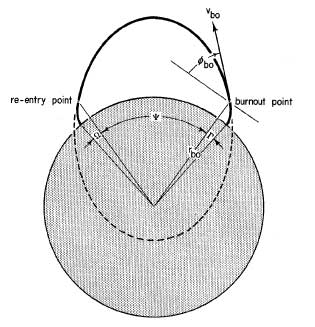 Figure 2: Ballistic trajectory |
However, because the booster did not impart enough velocity, the payload ends up impacting the Earth instead of continuing around in orbit. After burnout, both the satellite and missile warhead are ballistic objects, meaning their flight path is determined by the force of gravity and orbital mechanics.
The performance factor of a booster is called the Q, and it is defined as the ratio of the velocity the booster imparts on a payload at burnout altitude to the velocity needed to remain in orbit at that altitude. If the Q of a booster is less than 1, the booster can only place objects on ballistic arcs. . If Q is greater than 1, it can either put payloads on a sub-orbital or orbital trajectory.
| In theory, a space launch vehicle can be de-tuned and used as a ballistic missile. Likewise, many ICBMs are capable of being turned into space launch vehicles with relatively minor changes in performance. |
In the case of the United States and the former Soviet Union, if the ballistic missiles used to deliver nuclear weapons have a Q factor of less than 1, then the only possible route to reach the other country is a suborbital arc over the North Pole, somewhere between a low or “flat” trajectory and a high or “lofted” trajectory. This scenario is illustrated in Figure 3. In this case, the angle between the launch and impact point can never be greater than 180° and the maximum range of the missile is somewhere within that angle. If a launch vehicle has a Q greater than 1, then it could either fly over the North Pole in a lofted trajectory or over the South Pole on an orbital trajectory. This is because Q > 1 allows for the angle between launch and impact point to be greater than 180°. This scenario is illustrated in Figure 4.
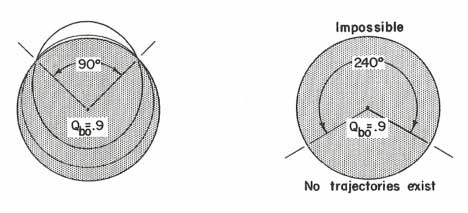 Figure 3: Trajectory Options for for Q < 1 |
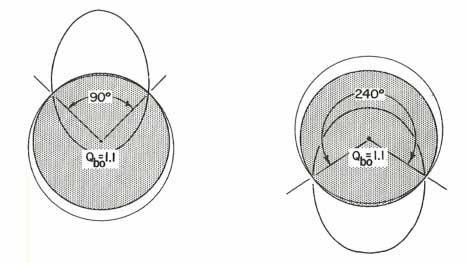 Figure 4: Trajectory Options for Q > 1 |
This Q factor becomes extremely important for ballistic missile arms control, and was a key stipulation of many of the arms control agreements between the United States and the Soviet Union. In the early 1960s the Soviet Union developed a nuclear delivery system with a Q greater than 1. The system, called the Fractional Orbital Bombardment System (FOBS), used a version of an SS-18 Satan missile with a modified upper stage to place a warhead in just such a southern trajectory as shown in Figure 4. This would allow it to approach the United States from the south, avoiding the extensive missile warning radar network which guarded the northern approaches. The FOBS system was banned as part of the SALT II Treaty and taken offline in 1983.
By definition, all space launch vehicles have a Q of greater than 1 because they are able to give a payload velocity equal to orbital speed. This also means that, in theory, a space launch vehicle can be de-tuned and used as a ballistic missile. Of course, modifications to the guidance and payload deployment system would have to be made for it to be capable of delivering any actual weapons, but it is feasible. Likewise, many intercontinental ballistic missiles (ICBMs) are capable of being turned into space launch vehicles with relatively minor changes in performance.
This conversion of ballistic missiles into space launch vehicles is not uncommon. The American Atlas and Titan families started life as ICBM programs, and modified versions ended life as space launch vehicles. The same modified SS-18 ICBM used for the Soviet FOBS program is now in service as the Russian Dnepr-1 space launch vehicle, and has even been fired from an operational Dombarovskiy ICBM base in Southern Russia. Even more interesting, Russia has converted two different types of ballistic missiles carried on board its nuclear-armed submarines for use as space launch vehicles. The first attempt at using one of these missiles to place a payload in orbit failed in 1998, but a later attempt in 2006 succeeded in placing the Kompas 2 satellite into orbit.
There are some states that have made the policy decision to clearly delineate between space launch vehicles used for peaceful purposes and ballistic missiles used as weapons. Sometimes this may be done through selection of the launch site, as is the case with the United States. The primary American military and civilian space launch facilities, Vandenberg Air Force Base in California and Cape Canaveral Air Force Station in Florida, are well removed from the operational ICBM fields in the middle of the country.
Other indicators may be the type of propellant used. Boosters built around solid rocket fuel or storable liquid propellants are an indication of a potential weapon, as their primary advantage is the ability to be kept in a launch-ready state for long periods of time. The disadvantages of both are lower specific impulse, along with solid rocket engine’s inability to throttle in real time and lower mass fractions. Cryogenics, such as liquid oxygen and liquid hydrogen, provide the best Isp for chemical rockets but cannot be kept in a launch-ready state due to the boil-off, and so are normally not used in ballistic missiles.
